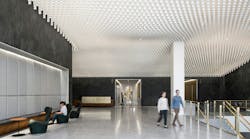Most of our recent workplace designs have dramatically increased the amount of meeting space available to the client. This happens not only because our clients usually ask for such increases, but our utilization studies tend to substantiate the need for more meeting areas.
In many ways, building a case for more meeting spaces in the modern (frequently more open) workplace is easy. Yet there is a larger underlying question that goes beyond simple space issues: what type of a collaborative culture is an organization trying to foster? More cool and tech enabled meeting rooms are usually a good thing, but more meetings are usually not. In the research we do—the surveys, focus groups, interviews and other studies—a typical refrain is that there are too many meetings and many meetings are “a waste of time.”
Our Outlook calendars overflow with status meetings, briefings, and team meetings, so much so that many of the employees we talk to—at law firms, financial services firms, and media companies—complain they don’t have any time “to get anything done.”
Much of the new focus on meeting effectiveness has come from the tech sector, which has long been using ”scrum” or “agile” workflows that encourage teams to work in an iterative manner and balance heads-down work with short bursts of collaboration. These methodologies prescribe a series of intentional meeting points along the way, including daily touch-base sessions that are brief but productive. As a result, these teams that are always connected and always recalibrating how they work. But they’re not spending hours in meetings. Other industries are taking note and have started to borrow some of these ideas.
Bloomberg, for example, has been in the news recently for having placed cartoons lampooning unnecessary meetings in all their conference rooms. It’s a not-so-subtle hint to staff to think twice before convening a long, formal meeting.
Some companies have also added countdown clocks in every meeting room so that you know how far into the session you are. When the clock starts flashing, it’s a reminder to occupants to move on to the decision-making stage or start talking next steps.
There is a big change-management component to shifting your meeting culture. Just building more collaborative spaces isn’t enough. For example, training staff to simply state the desired outcomes at the start of every meeting or making sure everyone understands why they are in a given meeting can have a huge impact.
A few years ago, we encouraged a client to adapt Bain Consulting’s RAPID®, an organization tool that calls for five standard roles in every meeting. After being trained in RAPID, employees became so accustomed to this that when they came into a meeting they would say, “I’m here as an ‘R,’ to Recommend solutions.” Or “I’m here as a ‘D’, to help decide.” And they learned which meetings required the full RAPID team verses those that only needed a couple of team members.
To support this new approach, Gensler developed design guidelines with a range of new meeting space types each with a deliberate purpose. For example, we designed a two-to-four person room with a white board for meetings when only a D, P, and A or two As and a D needed to get together. This may sound overly prescriptive, but along with the training we provided and the space design, it helped to create their desired collaborative culture.
As designers, we must start each project by figuring out what type of meeting behaviors our clients want to reinforce. The layout of meeting spaces says a lot about what the intent is—standing height tables with no chairs are not for long meetings, and workstations encircling a whiteboard wall may signal the expectation that the team will casually work together quite frequently.
In addition to designing the right mix of spaces, over the past five years we have been creating change management programs that outline effective collaboration methods. Increasingly these programs also cover how to use technology effectively in meetings and how to make sure tech isn’t an obstacle.
For example, we recently developed a curriculum for a client in California that was grappling with how to effectively conduct virtual meetings and to help staff better determine when an in-person gathering should be mandatory. A lot of the training is simply about being more deliberate and more mindful about making the most of your collaborative time.
After all, the world is too busy these days for any more bad meetings.
About the Author: Johnathan Sandler is one of the global leaders of Gensler's media practice, a role in which he digs deep to uncover how an organization works, its business objectives, and ways the new environment can help facilitate desired change. Contact him at [email protected].
About the Author
Gensler
A global design firm with more than 5,000 practitioners networked across five continents, Gensler features insights and opinions of architects and designers on how design innovation makes cities more livable, work smarter, and leisure more engaging. Our contributors write about projects of every scale, from refreshing a retailer’s brand to planning a new urban district, all the while explaining how great design can optimize business performance and human potential. For more thought leadership and blog content, visit our Research & Insight page. Follow us on Facebook, LinkedIn, and Twitter.


